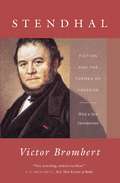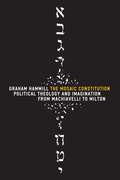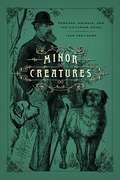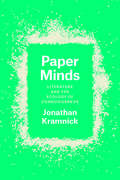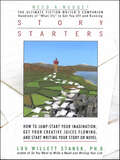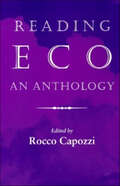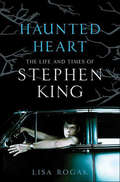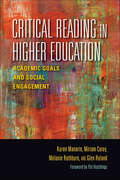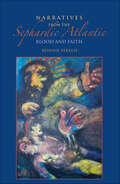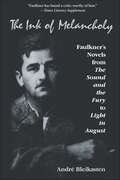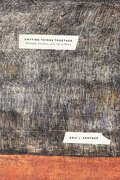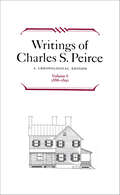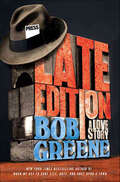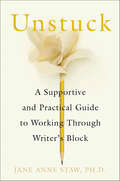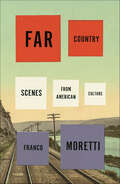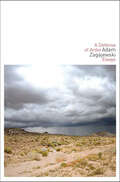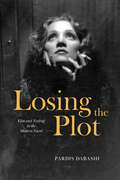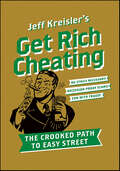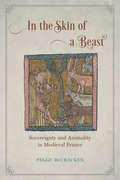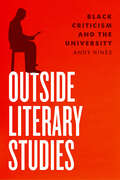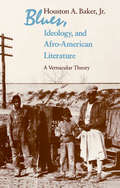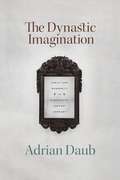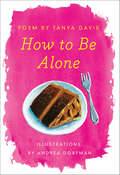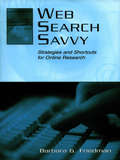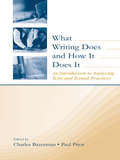- Table View
- List View
Stendhal: Fiction and the Themes of Freedom
by Victor BrombertVictor Brombert is a lion in the study of French literature, and in this classic of literary criticism, he turns his clear and perspicacious gaze on the works of one of its greatest authors—Stendhal. Best remembered for his novels The Red and the Black and The Charterhouse of Parma, Stendhal is a writer of extraordinary insight into psychology and the many shades of individual and political liberty. Brombert has spent a lifetime reading and teaching Stendhal and here, by focusing on the seemingly contradictory themes of inner freedom and outer constraint within Stendhal’s writings, he offers a revealing analysis of both his work and his life. For Brombert, Stendhal’s work is deeply personal; elsewhere, he has written about the myriad connections between Stendhal’s ironic inquiries into identity and his own boyhood in France on the brink of World War II. Proceeding via careful and nuanced readings of passages from Stendhal’s fiction and autobiography, Brombert pays particular attention to style, tone, and meaning. Paradoxically, Stendhal’s heroes often feel most free when in prison, and in a statement of stunning relevance for our contemporary world, Brombert contends that Stendhal is far clearer than any writer before him on the “crisis and contradictions of modern humanism that . . . render political freedom illusory.” Featuring a new introduction in which Brombert explores his earliest encounters with Stendhal—the beginnings of his “affair” during a year spent as a Fulbright scholar in Rome—Stendhal remains a spirited, elegant, and resonant account.
The Mosaic Constitution: Political Theology and Imagination from Machiavelli to Milton
by Graham HammillIt is a common belief that scripture has no place in modern, secular politics. Graham Hammill challenges this notion in The Mosaic Constitution, arguing that Moses’s constitution of Israel, which created people bound by the rule of law, was central to early modern writings about government and state.Hammill shows how political writers from Machiavelli to Spinoza drew on Mosaic narrative to imagine constitutional forms of government. At the same time, literary writers like Christopher Marlowe, Michael Drayton, and John Milton turned to Hebrew scripture to probe such fundamental divisions as those between populace and multitude, citizenship and race, and obedience and individual choice. As these writers used biblical narrative to fuse politics with the creative resources of language, Mosaic narrative also gave them a means for exploring divine authority as a product of literary imagination. The first book to place Hebrew scripture at the cutting edge of seventeenth-century literary and political innovation, The Mosaic Constitution offers a fresh perspective on political theology and the relations between literary representation and the founding of political communities.
Minor Creatures: Persons, Animals, and the Victorian Novel (Animal Lives Ser.)
by Ivan KreilkampIn the nineteenth century, richly-drawn social fiction became one of England’s major cultural exports. At the same time, a surprising companion came to stand alongside the novel as a key embodiment of British identity: the domesticated pet. In works by authors from the Brontës to Eliot, from Dickens to Hardy, animals appeared as markers of domestic coziness and familial kindness. Yet for all their supposed significance, the animals in nineteenth-century fiction were never granted the same fullness of character or consciousness as their human masters: they remain secondary figures. Minor Creatures re-examines a slew of literary classics to show how Victorian notions of domesticity, sympathy, and individuality were shaped in response to the burgeoning pet class. The presence of beloved animals in the home led to a number of welfare-minded political movements, inspired in part by the Darwinian thought that began to sprout at the time. Nineteenth-century animals may not have been the heroes of their own lives but, as Kreilkamp shows, the history of domestic pets deeply influenced the history of the English novel.
Paper Minds: Literature and the Ecology of Consciousness
by Jonathan KramnickHow do poems and novels create a sense of mind? What does literary criticism say in conversation with other disciplines that addresses problems of consciousness? In Paper Minds, Jonathan Kramnick takes up these vital questions, exploring the relations between mind and environment, the literary forms that uncover such associations, and the various fields of study that work to illuminate them. Opening with a discussion of how literary scholarship’s particular methods can both complement and remain in tension with corresponding methods particular to the sciences, Paper Minds then turns to a series of sharply defined case studies. Ranging from eighteenth-century poetry and haptic theories of vision, to fiction and contemporary problems of consciousness, to landscapes in which all matter is sentient, to cognitive science and the rise of the novel, Kramnick’s essays are united by a central thematic authority. This unified approach of these essays shows us what distinctive knowledge that literary texts and literary criticism can contribute to discussions of perceptual consciousness, created and natural environments, and skilled engagements with the world.
Story Starters: How to Jump-Start Your Imagination, Get Your Creative Juices Flowing, and Start Writing Your Story or Novel
by Lou Willett StanekIf you have the passion and energy to write fiction, but have trouble finding an idea and getting started, this is the perfect book for you. Lou Willett Stanek has helped scores of new authors in her acclaimed writing workshops—and now she shows you how to look and listen, how to find stories and begin shaping them like a writer.Here's how to find inspiration from neighbors and strangers, reshape classic tales, cull current events and use other tricks of the writing trade so effectively you'll soon find yourself brimming with ideas, your imagination revved to its full potential. Begin with a snippet of overheard conversation, an unexpected event, a simple character trait, a place, a problem—Ms. Stanek teaches you to get past "what really happened" and reinvent reality in ways that will astound and delight you, and hold a reader's attention.Here too are hundreds of "what-ifs," simple situations you can guide to endlessly different conclusions—and use to learn new ways to fashion plot, describe character, develop conflict, paint with language, create a setting, employ flashbacks, build suspense, and much, much more. For every writer who could use a jump-start, from novice to pro, here is a book that will help you keep the faith and. . .Thousands of stories are just waiting to be told—by you. Get started!
Reading Eco: An Anthology (Advances in Semiotics)
by Rocco Capozzi"[READING ECO is a timely indication] of the fruitfulness of perceiving Eco as the same in his metamorphoses. [It also testifies] to a certain price that Eco and his readers must/may pay for the enormous pleasure and intellectual stimulus of being Eco and being with Eco." —The ComparatistUmberto Eco is, quite simply, a genius. He is a renowned medievalist, philosopher, novelist, a popular journalist, and linguist. He is as warm and witty as he is learned—and quite probably the best-known academic and novelist in the world today. The goal of this anthology is to examine his ideas of literary semiotics and interpretation as evidenced both in his scholarly work and in his fiction.
Haunted Heart: The Life and Times of Stephen King
by Lisa RogakA fascinating look at the life of the author who created such modern classics as Carrie, IT, and The Shining.One of the most prolific and popular authors in the world today, Stephen King has become part of pop culture history. But who is the man behind those tales of horror, grief, and the supernatural? Where do these ideas come from? And what drives him to keep writing at a breakneck pace after a thirty year career? In this unauthorized biography, Lisa Rogak reveals the troubled background and lifelong fears that inspire one of the twentieth century's most influential authors. King's origins were inauspicious at best. His impoverished childhood in rural Maine and early marriage hardly spelled out the likelihood of a blossoming literary career. But his unflagging work ethic and a ceaseless flow of ideas put him on the path to success. It came in a flash, and the side effects of sudden stardom and seemingly unlimited wealth soon threatened to destroy his work and, worse, his life. But he survived and has since continued to write at a level of originality few authors could ever hope to match. Despite his dark and disturbing work, Stephen King has become revered by critics and his countless fans as an all-American voice more akin to Mark Twain than H. P. Lovecraft. Haunted Heart chronicles his story, revealing the character of a man who has created some of the most memorable---and frightening---stories found in literature today. Stephen King on Stephen King:"I'm afraid of everything.""As a kid, I worried about my sanity a lot.""I am always interested in this idea that a lot of fiction writers write for their fathers because their fathers are gone.""Writing is an addiction for me.""I married her for her body, though she said I married her for her typewriter.""When you get into this business, they don't tell you you'll get cat bones in the mail." "You have to be a little nuts to be a writer.""There's always the urge to see somebody dead that isn't you."
Critical Reading in Higher Education: Academic Goals and Social Engagement (Scholarship of Teaching and Learning)
by Glen Ryland Melanie Rathburn Karen Manarin Miriam CareyFaculty often worry that students can't or won't read critically, a foundational skill for success in academic and professional endeavors. "Critical reading" refers both to reading for academic purposes and reading for social engagement. This volume is based on collaborative, multidisciplinary research into how students read in first-year courses in subjects ranging from scientific literacy through composition. The authors discovered the good (students can read), the bad (students are not reading for social engagement), and the ugly (class assignments may be setting students up for failure) and they offer strategies that can better engage students and provide more meaningful reading experiences.
Narratives from the Sephardic Atlantic: Blood and Faith (Sephardi and Mizrahi Studies)
by Ronnie PerelisIdentity, family, and community unite three autobiographical texts by New World crypto-Jews, or descendants of Jews who were forced to convert to Christianity in 17th-century Iberia and Spanish America. Ronnie Perelis presents the fascinating stories of three men who were caught within the matrix of inquisitorial persecution, expanding global trade, and the network of crypto-Jewish activity. Each text, reflects the unique experiences of the author and illuminates their shared, deeply rooted attachment to Iberian culture, their Atlantic peregrinations, and their hunger for spiritual enlightenment. Through these writings, Perelis focuses on the social history of transatlantic travel, the economies of trade that linked Europe to the Americas, and the physical and spiritual journeys that injected broader religious and cultural concerns into this complex historical moment.
The Ink of Melancholy: Faulkner's Novels from The Sound and the Fury to Light in August
by André BleikastenInk of Melancholy re-examines and re-evaluates William Faulkner's work from the late 1920s to the early 1940s, one of his most creative periods. Rather than approach Faulkner's fiction through a prefabricated grid, André Bleikasten concentrates on the texts themselves—on the motivations and circumstances of their composition, on the rich array of their themes, structures, textures, points of emphasis and repetition, as well as their rifts and gaps—while drawing on the resources of philosophy, psychoanalysis, anthropology. Brilliant in its thought and argument, Ink of Melancholy is one of the most insightful and stimulating studies of Faulkner's work.
Untying Things Together: Philosophy, Literature, and a Life in Theory
by Eric L. SantnerUntying Things Together helps to clarify the stakes of the last fifty years of literary and cultural theory by proposing the idea of a sexuality of theory. In 1905, Freud published his Three Essays on the Theory of Sexuality, the book that established the core psychoanalytic thesis that sexuality is central to formations of the unconscious. With this book, Eric L. Santner inverts Freud’s title to take up the sexuality of theory—or, more exactly, the modes of enjoyment to be found in the kinds of critical thinking that, since the 1960s, have laid claim to that ancient word, “theory.” Santner unfolds his argument by tracking his own relationship with this tradition and the ways his intellectual and spiritual development has been informed by it.Untying Things Together is both an intellectual history of major theoretical paradigms and a call for their reexamination and renewal. Revisiting many of the topics he has addressed in previous work, Santner proposes a new way of conceptualizing the eros of thinking, attuned to how our minds and bodies individually and collectively incorporate or “encyst” on a void at the heart of things. Rather than proposing a “return to theory,” Santner’s book simply employs theory as a way of further “(un)tying together” the resources of philosophy, art and literature, theology, psychoanalysis, political thought, and more.
Writings of Charles S. Peirce: A Chronological Edition (Writings of Charles S. Peirce)
by Charles S. PeirceVolume 6 of this landmark edition contains 66 writings mainly from the unsettled period in Peirce's life just after he moved from New York to Milford, Pennsylvania, followed shortly afterward by the death of his mother. The writings in this volume reveal Peirce's powerful mind probing into diverse issues, looking for an underlying unity, but, perhaps, also looking for direction.
Late Edition: A Love Story
by Bob GreeneA loving and laughter-filled trip back to a lost American time when the newspaper business was the happiest game in town.In a warm, affectionate true-life tale, New York Times bestselling author Bob Greene (When We Get to Surf City, Duty, Once Upon a Town) travels back to a place where—when little more than a boy—he had the grand good luck to find himself surrounded by a brotherhood and sisterhood of wayward misfits who, on the mezzanine of a Midwestern building, put out a daily newspaper that didn't even know it had already started to die."In some American cities," Greene writes, "famous journalists at mighty and world-renowned papers changed the course of history with their reporting." But at the Columbus Citizen-Journal, there was a willful rejection of grandeur—these were overworked reporters and snazzy sportswriters, nerve-frazzled editors and insult-spewing photographers, who found pure joy in the fact that, each morning, they awakened to realize: "I get to go down to the paper again."At least that is how it seemed in the eyes of the novice copyboy who saw romance in every grungy pastepot, a symphony in the song of every creaking typewriter. With current-day developments in the American newspaper industry so grim and dreary, Late Edition is a Valentine to an era that was gleefully cocky and seemingly free from care, a wonderful story as bracing and welcome as the sound of a rolled-up paper thumping onto the front stoop just after dawn.
Unstuck: A Supportive and Practical Guide to Working Through Writer's Block
by Jane Anne StawNone of us is immune to writer's block. From well-known novelists to students, associates in business and law firms, and even those who struggle to sit down to write personal correspondence or journal entries -- everyone who writes has experienced either brief moments or longer periods when the words simply won't come. In Unstuck, poet, author and writing coach Jane Anne Staw uncovers the reasons we get blocked - from practical to emotional, and many in between - and offers powerful ways to get writing again. Based on her experiences working with writers as well as her own struggle with writer's block, Staw provides comfort and encouragement, along with effective strategies for working through this common yet vexing problem.Topics include: understanding what's behind the block * handling anxiety and fear * carving out time and space to write * clearing out old beliefs and doubts * techniques to relax and begin * managing your expectations as well as those of family and friends * experimenting with genre, voice, and subject matter * defusing the emotional traps that sabotage progress and success * ending the struggle and regaining confidence and freedom by finding your true voice - and using it. Writers of all levels will find solace, support, and help in this book, leading them to an even deeper connection with their work and more productivity on the page.
Far Country: Scenes from American Culture
by Franco MorettiThe influential and controversial critic takes literary history out of the classroom and into the publicIn the field of literary history and theory, Franco Moretti is synonymous with innovation. The cofounder of the Stanford Literary Lab, he brought quantitative methods into the study of the novel, enabling a “distant” reading that uses computation to analyze literary production over centuries. But at the same time, he was also teaching undergraduates the history of literature. Knowing Moretti, it’s no surprise that he didn’t teach the course the accepted way: one author after another, in a long uninterrupted chain. Instead, he put an irregular chessboard in front of his students that was too strange to be taken for granted. Literary history had become a problem, and he offered a solution.In Far Country, Moretti take these lectures out of the classroom and lets us share in the passion and excitement that comes from radical critique. Unconstrained by genre, Moretti juxtaposes Whitman and Baudelaire, the Western and film noir, even Rembrandt and Warhol, illuminating each through their opposition. With his guidance, we revel in the process of transformation—the earthquakes that shook the “how” of artistic form—and begin to shape a new view on American culture.Bracing in its insight and provocative in its conclusions, Far Country is a critical look at the development of American cultural hegemony.
A Defense of Ardor: Essays
by Adam ZagajewskiArdor, inspiration, the soul, the sublime: Such terms have long since fallen from favor among critics and artists alike. In his new collection of essays, Adam Zagajewski continues his efforts to reclaim for art not just the terms but the scanted spiritual dimension of modern human existence that they stake out. Bringing gravity and grace to his meditations on art, society, and history, Zagajewski wears his erudition lightly, with a disarming blend of modesty and humor. His topics range from autobiography (his first visit to a post-Soviet Lvov after childhood exile; his illicit readings of Nietzsche in Communist Poland); to considerations of artist friends past and present (Zbigniew Herbert, Czeslaw Milosz); to intellectual and psychological portraits of cities he has known, east and west; to a dazzling thumbnail sketch of postwar Polish poetry.Zagajewski gives an account of the place of art in the modern age that distinguishes his self-proclaimed liberal vision from the "right-wing radicalism" of such modernist precursors as Eliot or Yeats. The same mixture of ardor and compassion that marks Zagajewski's distinctive contribution to modern poetry runs throughout this eloquent, engaging collection.
Losing the Plot: Film and Feeling in the Modern Novel
by Pardis DabashiAn examination of the relationship between literature and classical Hollywood cinema reveals a profound longing for plot in modernist fiction. The modernist novel sought to escape what Virginia Woolf called the “tyranny” of plot. Yet even as twentieth-century writers pushed against the constraints of plot-driven Victorian novels, plot kept its hold on them through the influence of another medium: the cinema. Focusing on the novels of Nella Larsen, Djuna Barnes, and William Faulkner—writers known for their affinities and connections to classical Hollywood—Pardis Dabashi links the moviegoing practices of these writers to the tensions between the formal properties of their novels and the characters in them. Even when they did not feature outright happy endings, classical Hollywood films often provided satisfying formal resolutions and promoted normative social and political values. Watching these films, modernist authors were reminded of what they were leaving behind—both formally and in the name of aesthetic experimentalism—by losing the plot.
Get Rich Cheating: The Crooked Path to Easy Street
by Jeff KreislerIn these difficult times, there's only one proven path to ridiculous amounts of money: Cheating. Everyone's doing it—from sleazy CEOs to 'roided-up home run kings, silicone-enhanced starlets, and backroom-dealing congressmen—so why not you? Get Rich Cheating is your definitive guide to the illegal, immoral, and fun, detailing the schemes that have proven time and time again to generate more cash than God, Google, and the Treasury combined. No one ever bought a fleet of Bentleys with hard work, perseverance, and honesty. Simply by purchasing this book, you've already done more than most "ethical" people dare. Open it, savor the moment, and inhale deeply in the musk of your impending wealth—it's time to Get Rich Cheating.
In the Skin of a Beast: Sovereignty and Animality in Medieval France
by Peggy McCrackenIn medieval literature, when humans and animals meet—whether as friends or foes—issues of mastery and submission are often at stake. In the Skin of a Beast shows how the concept of sovereignty comes to the fore in such narratives, reflecting larger concerns about relations of authority and dominion at play in both human-animal and human-human interactions. Peggy McCracken discusses a range of literary texts and images from medieval France, including romances in which animal skins appear in symbolic displays of power, fictional explorations of the wolf’s desire for human domestication, and tales of women and snakes converging in a representation of territorial claims and noble status. These works reveal that the qualities traditionally used to define sovereignty—lineage and gender among them—are in fact mobile and contingent. In medieval literary texts, as McCracken demonstrates, human dominion over animals is a disputed model for sovereign relations among people: it justifies exploitation even as it mandates protection and care, and it depends on reiterations of human-animal difference that paradoxically expose the tenuous nature of human exceptionalism.
Outside Literary Studies: Black Criticism and the University
by Andy HinesA timely reconsideration of the history of the profession, Outside Literary Studies investigates how midcentury Black writers built a critical practice tuned to the struggle against racism and colonialism. This striking contribution to Black literary studies examines the practices of Black writers in the mid-twentieth century to revise our understanding of the institutionalization of literary studies in America. Andy Hines uncovers a vibrant history of interpretive resistance to university-based New Criticism by Black writers of the American left. These include well-known figures such as Langston Hughes and Lorraine Hansberry as well as still underappreciated writers like Melvin B. Tolson and Doxey Wilkerson. In their critical practice, these and other Black writers levied their critique from “outside” venues: behind the closed doors of the Senate Permanent Subcommittee on Investigations, in the classroom at a communist labor school under FBI surveillance, and in a host of journals. From these vantages, Black writers not only called out the racist assumptions of the New Criticism, but also defined Black literary and interpretive practices to support communist and other radical world-making efforts in the mid-twentieth century. Hines’s book thus offers a number of urgent contributions to literary studies: it spotlights a canon of Black literary texts that belong to an important era of anti-racist struggle, and it fills in the pre-history of the rise of Black studies and of ongoing Black dissent against the neoliberal university.
Blues, Ideology, and Afro-American Literature: A Vernacular Theory
by Houston A. Baker Jr.Relating the blues to American social and literary history and to Afro-American expressive culture, Houston A. Baker, Jr., offers the basis for a broader study of American culture at its "vernacular" level. He shows how the "blues voice" and its economic undertones are both central to the American narrative and characteristic of the Afro-American way of telling it.
The Dynastic Imagination: Family and Modernity in Nineteenth-Century Germany
by Adrian DaubAdrian Daub’s The Dynastic Imagination offers an unexpected account of modern German intellectual history through frameworks of family and kinship. Modernity aimed to brush off dynastic, hierarchical authority and to make society anew through the mechanisms of marriage, siblinghood, and love. It was, in other words, centered on the nuclear family. But as Daub shows, the dynastic imagination persisted, in time emerging as a critical stance by which the nuclear family’s conservatism and temporal limits could be exposed. Focusing on the complex interaction between dynasties and national identity-formation in Germany, Daub shows how a lingering preoccupation with dynastic modes of explanation, legitimation, and organization suffused German literature and culture. ? Daub builds this conception of dynasty in a syncretic study of literature, sciences, and the history of ideas, engaging with remnants of dynastic ideology in the work of Richard Wagner, Émile Zola, and Stefan George, and in the work of early feminists and pioneering psychoanalysts. At every stage of cultural progression, Daub reveals how the relation of dynastic to nuclear families inflected modern intellectual history.
How to Be Alone
by Tanya DavisSince its debut on YouTube, Tanya Davis’s beautiful and perceptive poem "How to Be Alone," visually realized by artist and filmmaker Andrea Dorfman, has become an international sensation. In this edition of How to Be Alone, they have adapted the poem and its compelling illustrations for the page in a beautiful, meditative volume—a keepsake to treasure and to share. From a solitary walk in the woods to sitting unaccompanied on a city park bench to eating a meal and even dancing alone, How to Be Alone, reveals the possibilities and joys waiting to be discovered when we engage in activities on our own. As she soothes the disquietude that accompanies the fear of aloneness, and celebrates the power of solitude to change how we see ourselves and the world, Tanya reveals how, removed from the noise and distractions of other lives, we can find acceptance and grace within.For those who have never been by themselves or those who embrace being on their own, How to Be Alone encourages us to recognize and embrace the possibilities of being alone—and reminds us of a universe of joy, peace, and discovery waiting to unfold.
Web Search Savvy: Strategies and Shortcuts for Online Research (Routledge Communication Series)
by Barbara G. FriedmanWeb Search Savvy: Strategies and Shortcuts for Online Research provides readers of all skill levels with efficient search strategies for locating, retrieving, and evaluating information on the Internet. Utilizing her experience as a reporter working on deadline, author Barbara G. Friedman offers the most effective methods for finding useful and trustworthy data online, and presents these techniques in a straightforward, user-friendly manner.Anyone who uses the Internet for research will find much of value here, including techniques that harness the power of advanced searches to optimize search results, avoid advertising clutter, and locate low- or no-cost databases. Screen captures and diagrams illustrate the steps, rationale, and results to accompany various search strategies. This book emphasizes techniques that make the Web work for individuals rather than for advertisers, such as choosing the most appropriate search engine for the job and tweaking its advanced options to narrow a search and optimize results; identifying cost-free sources of online data; using creative approaches to locate information; evaluating the integrity of online data; and protecting the privacy of the researchers and the researched.Web Search Savvy is an essential resource for students, scholars, and practitioners in journalism and mass communications, and it offers practical and useful guidance for anyone researching information online.
What Writing Does and How It Does It: An Introduction to Analyzing Texts and Textual Practices
by Paul Prior Charles BazermanIn What Writing Does and How It Does It, editors Charles Bazerman and Paul Prior offer a sophisticated introduction to methods for understanding, studying, and analyzing texts and writing practices. This volume addresses a variety of approaches to analyzing texts, and considers the processes of writing, exploring textual practices and their contexts, and examining what texts do and how texts mean rather than what they mean. Included are traditional modes of analysis (rhetorical, literary, linguistic), as well as newer modes, such as text and talk, genre and activity analysis, and intertextual analysis. The chapters have been developed to provide answers to a specified set of questions, with each one offering:*a preview of the chapter's content and purpose; *an introduction to basic concepts, referring to key theoretical and research studies in the area;*details on the types of data and questions for which the analysis is best used; *examples from a wide-ranging group of texts, including educational materials, student writing, published literature, and online and electronic media; *one or more applied analyses, with a clear statement of procedures for analysis and illustrations of a particular sample of data; and*a brief summary, suggestions for additional readings, and a set of activities. The side-by-side comparison of methods allows the reader to see the multi-dimensionality of writing, facilitating selection of the best method for a particular research question. The volume contributors are experts from linguistics, communication studies, rhetoric, literary analysis, document design, sociolinguistics, education, ethnography, and cultural psychology, and each utilizes a specific mode of text analysis. With its broad range of methodological examples, What Writing Does and How It Does It is a unique and invaluable resource for advanced undergraduate and graduate students and for researchers in education, composition, ESL and applied linguistics, communication, L1 and L2 learning, print media, and electronic media. It will also be useful in all social sciences and humanities that place importance on texts and textual practices, such as English, writing, and rhetoric.
